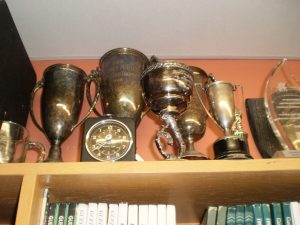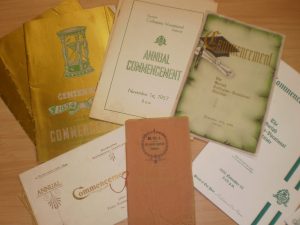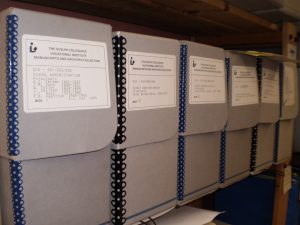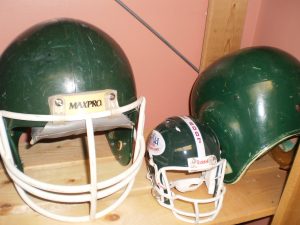Archives
 |
 |
 |
 |
Wendy, 1974 alumna, volunteers in the school Archives and is able to assist you with questions or with memorabilia donations. Please call the school Archives before you arrive because it is a volunteer position and hours are flexible. She is there most Monday and Wednesday afternoons during the school year.
The Guelph Collegiate-Vocational Institute
P.G. Reid Library Learning Commons
& Archives
Introduction
According to Leo Johnson, academic and historian, Egerton Ryerson, the Provincial Superintendent of Education introduced legislation in 1850 calling for the establishment of local “free” public schools, supported by real estate taxation. This was not a popular decision since it meant city councils would be responsible for raising funds by increasing taxes, and students would be required to attend school all day and would not be available to work during the school year.
To ensure that all children had space to learn and study, the Guelph Grammar School Board at the time contracted to build a new building in 1854 on Arnold Street near Paisley. As the number of school-age children increased, the Board of Education for Guelph began the building of the Guelph High School in 1879, retaining only the rear part of the old Grammar School. In 1887 the Guelph High School was raised to the standard of a Collegiate Institute. This meant that it offered courses in the arts and humanities, including Greek and Latin, and prepared students for university (Johnson, Leo. History of Guelph 1827-1927. Guelph: Guelph Historical Society, June 1977, 238-245).
Over the years, Guelph Collegiate has graduated many well-known students who have made significant contributions to Canadian society. Some of these students are honoured on the school’s Wall of Fame in the main corridor, and include such people as John McCrae, George Drew, Jean Little, Kenneth McAlister, and Arthur Cutten. The Wall of Fame is sponsored by the GCVI Alumni Association and continues to this day with students researching, interviewing and writing short biographies. Over the years the school has also had loyal groups of graduates who continue to establish scholarships, visit the school, and donate materials to the archives. One group, in particular, was the class of 1933, whose classmate, Kenneth McAlister was taken prisoner by the Germans behind enemy lines and executed in the Second World War.
Establishment and Growth of the School’s Archives
Much of the credit for the creation of GCVI’s school archives goes to Peter Gordon Reid. Mr. Reid taught Guidance and History, and then became Principal of GCVI. He was at GCVI from January 1948 to June 1971. As an avid historian he ensured that there was a storage area for archival materials in the new library which opened in the fall of 1969 with 6,000 volumes. The new library was located in the former swimming pool area. After his retirement he continued to encourage former staff and students to donate materials related to the history of the school.
John Currie, a history teacher and teacher-librarian, was also keenly interested in the school’s archives, and in the fall of 1977, with Bill McKinnie as the new Library Head, the two of them took on the project of sorting and promoting the collection for student research and for people in the community. During his time the collection was moved to a larger room in the library; shelving, Hollinger acid-free containers and acid-free filing folders were purchased; and an organizational model for the collection was created based on archival principles. Much of the sorting was done for 15 years by a parent volunteer, Erica Morant. Mary Mulholland took over the Head of Library position after Bill McKinnie retired from 23 years in the library. With the help of John Mahnic, artist and teacher at GC, they had almost 20 GC sport team photographs and crests professionally framed and placed around the main library. Some paintings were restored professionally and framed and these also proudly hang on the library walls. Tanya Drimmie came to GCVI in 2012 and purchased the first Archives laptop to start the process of digitizing all our Archives files and material. Ms. Wendy Darroch, a GC graduate and retired Office Coordinator, is computerizing the collection finding aid and continues to receive new acquisitions. Her dedicated work has certainly improved access to a growing collection. Wendy very much appreciates the guidance and assistance she received from Ms. Kim Sommerville, former Archives Assistant at the Wellington County Museum & Archives, who developed the model for the computerized finding aid.
Purpose of the Collection
The purpose of the GCVI archives is to collect and preserve the documented history of our school. These records are noncurrent and are valuable because of their continuing administrative, legal, or research value. They are made available to researchers subject to some restrictions on access. As well as their research value, the archives is also used to promote a sense of pride in the school’s history which dates back to 1829 when John Galt built the first stone school in Guelph.
The purpose of the GCVI archives is to collect and preserve the documented history of our school. These records are noncurrent and are valuable because of their continuing administrative, legal, or research value. They are made available to researchers subject to some restrictions on access. As well as their research value, the archives is also used to promote a sense of pride in the school’s history which dates back to 1829 when John Galt built the first stone school in Guelph.
Nature of the Collection
Interesting materials include a framed photograph of John McCrae taken about the time of the Boer War, and a 1938 picture of McCrae donated to the school in 1938 by the John McCrae Memorial Branch #257 of the Canadian Legion. Throughout the library there are many pictures of early sports teams, and Board administrators. The oldest record in the collection is a certificate present to Edward Chadwich in 1854 for a translation of Euclid. We have a complete set of Acta Nostras dating back to 1926.
The collection includes such items as
1) financial records: minute books, annual reports, general ledgers and journals
2) biographical records: papers of former principals and teachers, day books and mark books, scrapbooks, oral history tape recordings
3) photographic and cartographic records: photographs, movies and videos, maps and plans
4) publications: yearbooks, school newspapers, commencement programs, histories
5) organizational records: ministry documents, documents from others professional organizations
6) administrative and operational: memos from principals, vice-principals, minutes from staff and heads’ meetings, staff bulletins, and board of education directives.
7) artifacts: for example, old science equipment, silver tea service used in Home Economics classes, football jackets, trophies, et cetera
8) textbooks: a representative sample as well as some antiquarian books.
Organization of the Collection
The collection is organized by record group and then by series. Much of the material is organized by department, (a record group); for example, the English department, and then by series like courses of study, exams, memos, assignments, day books, budgets, class lists, reports, pictures, created or received by the English department.
Access to the Collection
You are certainly welcome to visit our school archives and to donate items relating to our school’s unique history. However, visiting the archives collection is a different experience from visiting the library learning commons. Due to the uniqueness, fragility and privacy laws surrounding some of our items, the archives is not an open-access facility and restrictions are placed on records that contain personal information. We offer reference services via e-mail, phone and in person by appointment. Please contact the P. G. Reid Library Learning Commons at 519-824-9800 ext. 313.
Bill McKinnie
John Currie
Wendy Darroch
May 2016


